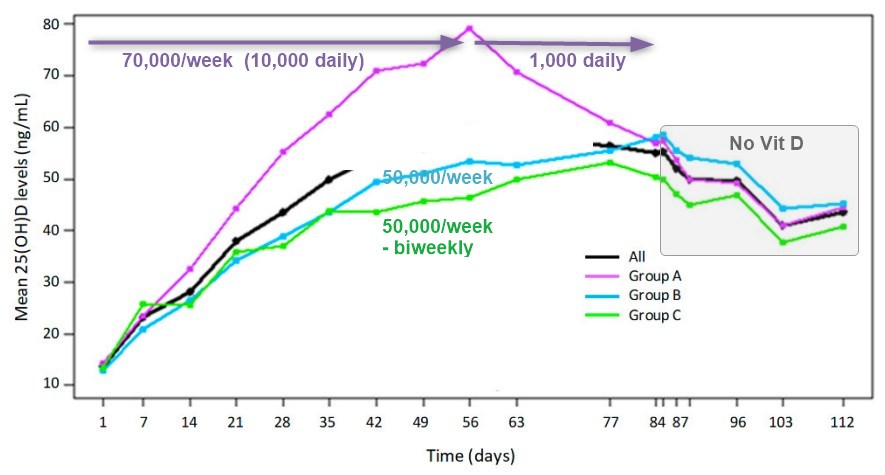Weekly 50,000 IU of vitamin D is again found to be good – RCT
Pharmacokinetics of Oral Cholecalciferol in Healthy Subjects with Vitamin D Deficiency: A Randomized Open-Label Study
Nutrients 2020, 12(6), 1553; https://doi.org/10.3390/nu12061553

Yes, 70k per week is better than 50k. Likewise 100k per week would be even better
Almost 2 months to fully respond to 50,000 IU weekly if no loading dose

by Angelo Fassio 1,*,Giovanni Adami 1OrcID,Maurizio Rossini 1OrcID,Alessandro Giollo 1,Cristian Caimmi 1,Riccardo Bixio 1,Ombretta Viapiana 1,Stefano Milleri 2,Matteo Gatti 1 and Davide Gatti 1
1 Rheumatology Unit, University of Verona, 37131 Verona, Italy
2 Centro Ricerche Cliniche di Verona SRL, 37131 Verona, Italy
Download the PDF from VitaminDWiki
Background: the aim of this study was to investigate the pharmacokinetic (PK) and safety profile of high-dose vitamin D supplementation, comparing different schedules (daily, weekly, or bi-weekly) in an otherwise healthy vitamin D-deficient population.
Methods: single-center, open-label study on healthy subjects deficient in vitamin D (25 (OH)D < 20 ng/mL), randomized to receive cholecalciferol (DIBASE®, Abiogen Pharma, Italy) using three different schedules:
Group A: 10,000 IU/day for eight weeks followed by 1000 IU/day for four weeks;
Group B: 50,000 IU/week for 12 weeks,
Group C: 100,000 IU/every other week for 12 weeks.
Total cumulative doses were: 588,000 IU, 600,000 IU, 600,000 IU. The treatment regimens corresponded to the highest doses allowed for cholecalciferol for the correction of vitamin D deficiency in adults in Italy.
Results: mean 25 (OH)D plasma levels significantly increased from baseline 13.5 ± 3.7 ng/mL to peak values of 81.0 ± 15.0 ng/mL in Group A, 63.6 ± 7.9 ng/mL in Group B and 59.4 ± 12 ng/mL in Group C. On day 28, all subjects showed 25 (OH)D levels ≥ 20 ng/mL and 93.1% had 25 (OH)D levels ≥ 30 ng/mL. On day 56 and 84, all subjects had 25 (OH)D levels ≥ 30 ng/mL. No serious adverse events occurred during the study.
Conclusions: normalization of 25 (OH)D serum levels was quickly attained with all the studied regimens. A more refracted schedule provided a higher systemic 25 (OH)D exposure.
Short URL = https://is.gd/50Kweekly
